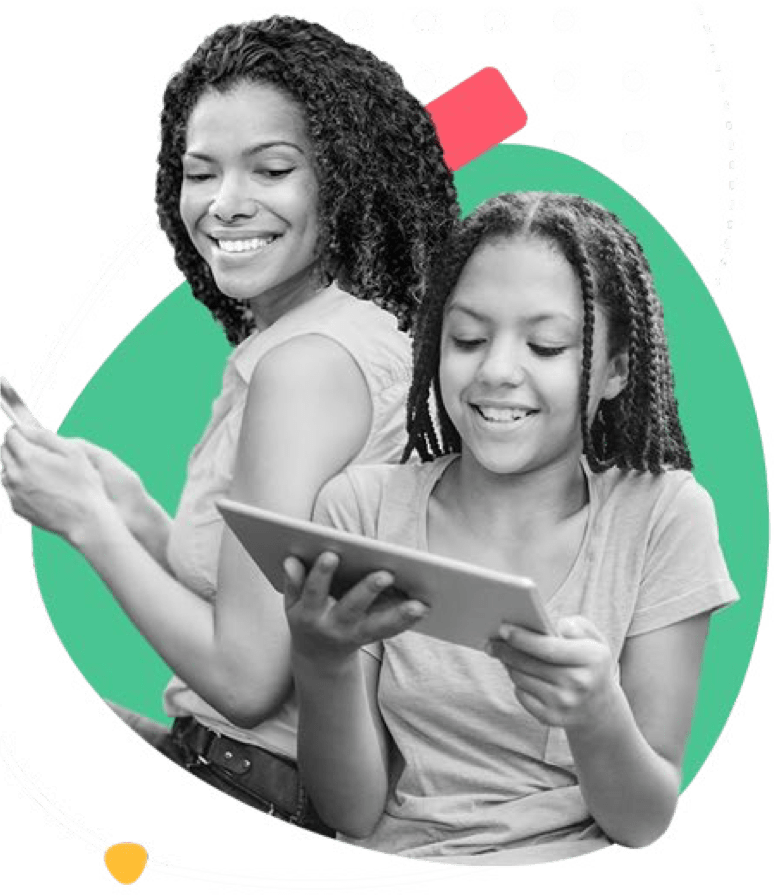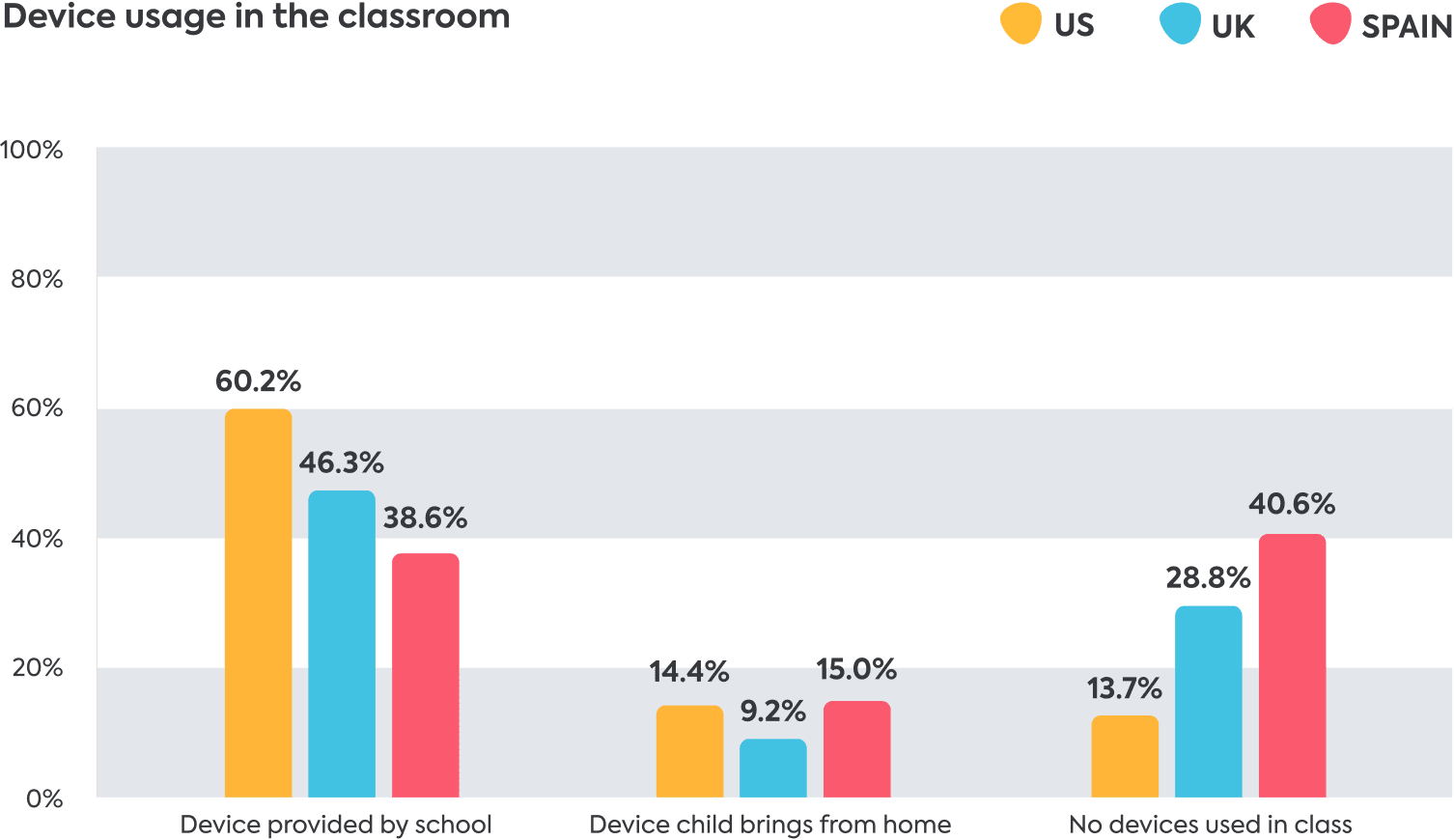THE QUSTODIO ANNUAL DATA REPORT 2021
Living and learning in a digital world
The complete snapshot of how children are living and growing with technology.
A full view of digital trends and usage in 2021 globally and across three major markets, including screen time, social media, and gaming, paired with how children are learning and developing in a rapidly changing environment.
In this report
ABOUT THIS REPORT
Three years ago, we released our first annual report looking into children’s digital habits, offering insights into their app activity across 2019. Shortly after, when the coronavirus pandemic began to alter technology habits across the globe, we released the direct, immediate effects it was having on children’s app habits across the first few months of 2020.
Our 2021 report follows in the footsteps of our second annual report, where we analyzed children’s habits globally, and in three major markets (the US, the United Kingdom, and Spain) across 2020. These reports investigate children’s use of technology across five popular categories – online video, social media, gaming, education, and communication apps. In each category, we present graphs and information detailing the most popular apps based on the percentage of children using them, the time spent on kids’ most popular apps, the time spent per app category overall, and the apps that parents most frequently blocked in 2021.
In this year’s report, we have directly involved children and families in our research, through surveys and interviews that allow them to share their unique perspective on technology and family life. These insights, combined with our own app research, allow us a window into how families are facing the rapid development of technology and how it fits into many aspects of their lives, from hobbies to education.
This report offers a snapshot of the digital world, through younger, fresher eyes. In addition to children’s daily habits, we’ll explore how technology is becoming an indispensable tool in education, bringing the classroom online and ever-present, even when school’s out for the day. Through the insights gained, we’ll develop a further understanding of what it means to grow up with technology, so we can reap its benefits and enjoy the true positives for many years to come.
ABOUT QUSTODIO
Founded in 2012 by cyber-security experts Eduardo Cruz, Josep Gaspar, and Josh Gabel, Qustodio is the world leader in online safety and digital wellbeing for families. We believe everyone has the right to a safe and secure digital experience, and provide a cross-platform solution for families and schools, helping parents and educators protect their children from online harm, while promoting healthy digital habits and awareness. As technology lovers, we’ve made it our mission to help families and schools live and navigate smarter in an increasingly connected world.

Introduction
If 2020 was a year of change, then 2021 was the year the world accepted, and adapted as a result. We adapted to meetings held over Zoom. We adapted to dance classes, cooking courses and gardening tips through a screen. We adapted to the constant buzz of an update in our pockets, and as time passed, we adapted to ignoring them, beginning to understand the toll that being constantly connected was taking on our daily lives.
Screen time, which global trends were already showing to be on the rise during 2019, suddenly hit an all-time high, skyrocketing to unprecedented levels as we lived and breathed the online world: work, studying, classes and lectures, checking on our families and friends, and even exercise went digital for months at a time. With many parents working from home, screens became the only way to keep children entertained for hours at a time. But with lockdowns easing over the world, the words “new normal” began to creep into our daily lives.
WHAT DID THE NEW NORMAL MEAN FOR 2021?
For some, it was back to school, back to work – with a few small changes. But for many others, the extended time in front of screens stuck. Children could be back in school for one week, then distance learning the next. Companies around the world went fully remote, or switched to hybrid approaches, with employees working from home much of the time. Children and adults alike hopped from screen to screen, closing the laptop at 3pm to be met with a space once filled with after-school activities or the daily commute, and instead switching on the video game console, scrolling social media, or turning on the TV simply because there was nothing else to do.
The long-term effects of our reliance on technology and screens are still unknown, and the pandemic’s influence on Generation Z and Alpha, the youngest generations during coronavirus times, will not fully be seen for years to come. However, through the millions of families using Qustodio, we are able to see first-hand the effect this new fully digital lifestyle is having, and the risks that children are being exposed to as a result of excessive screen time. Throughout this report, we’ve brought these voices to life by including select insights from our interviews with children around the world, which serve to help us understand how kids use technology in 2021, and their true feelings surrounding it.
Methodology
This report is based on anonymous information provided by 400,000 families with children aged 4-18 years old from around the world, along with deeper insights from children in the United States, the United Kingdom, and Spain. It reveals their online app habits from January 1, 2021, to December 31, 2021, compared with information from the same period across 2020. This year we have included additional insights from applications used on desktop computers, the use of which becomes more relevant as children mature and the need for more productivity-based devices increases. When analyzing time spent online during school hours, we based our exploration on the typical school day in each country: 8am to 3pm in the US, 9am to 3pm in the UK, and 9am to 5pm in Spain.
In order to better understand how families view and use technology in their daily lives, we surveyed 1200 parents across the US, UK, and Spain. In addition, our report includes individual insights from 121 children aged 10-13 representing the same three countries, who we interviewed to share their unique understanding of their digital lives and online experiences. We would like to extend our gratitude to the many families and children who helped contribute to this report.
To further explore children’s online habits, we have divided the insights across five popular app categories: online video, social media, gaming, education, and communication. Some types of application are frequent multi-taskers, easily fitting into more than one category. For the sake of simplicity, we have chosen just one category per app. For example, while YouTube allows users to comment and encourages social sharing, we have classified it as online video, along with other live video streaming services such as Twitch. For education apps, in terms of popularity, we divided the category into two sub-categories: classroom management apps like Google Classroom and Show My Homework, and learning apps, such as Duolingo and Khan Academy.
To provide a better picture of the specific apps and websites kids are using, our research also excludes “game launchers” such as Epic Games Launcher and Steam, email platforms like Gmail or native phone apps like Phone. In addition, our insights exclude gambling apps as a whole.

Families and technology in 2021
As a reflection of our increasingly connected world, most households now make use of multiple devices. In our survey, which investigated how technology forms a part of children’s daily lives in the US, UK, and Spain, along with their parents’ viewpoints on tech usage, we found that 47% of children are regularly using 3 or more devices, and 75% use at least 2 different digital devices on a daily basis. Parents report that their children spend most time connected to their cell phones, with 62% of kids aged between 5 and 15 having their own phone. 58% of children regularly use a tablet, closely followed by gaming consoles, with 56% of parents responding that their children used one on a daily basis.


Globally, children are frequently spending time online outside of school hours, with 38% of kids aged 5-15 spending between 1-2 hours a day connected, and 31% spending over 2 hours online every day. Unsurprisingly, time spent online rises over the weekend, with 53% of children connecting for over 2 hours a day. Children in the UK and US spend more time online than their Spanish counterparts – 58% of UK kids and 57% of children in the US spend over 2 hours online at the weekend, compared to just 44% of kids in Spain.
Despite the fact that their children are the least “connected” of the three countries, parents in Spain are more concerned about the amount of time their children are spending on devices: up to two-thirds of Spanish parents (66%) affirmed that they are very or extremely concerned, compared to just 18% of British parents, and 29% in the US.
Children themselves are also recognizing the increased time they are spending online: 23% of the children we interviewed, the majority of them Spanish, felt that they now spent too much time using technology.
Most parents notice the effect of technology on their children and their behavior, but acknowledge that along with the bad, comes the good: 64% of parents assert that technology has both positive and negative impacts on their children, compared to just 12% observing only negative effects, and a slightly higher 15% of parents noticing only positive.

CREATING AN ON AND OFFLINE BALANCE
Faced with hyper-connectivity, and little downtime away from screens, parents use many different strategies to help their children create the appropriate on-offline balance.
80% of the families surveyed asserted that they used some form of supervision or limitation over their child’s technology use. Again, Spanish parents displayed an increased level of concern, with 87% reporting that they supervise or limit their child’s time online. Most families choose to limit the time their kids spend surfing the internet (46%), or playing video games (52%). However, a significant amount of families (46%) use a parental control tool or content filter to help their children manage their device use, with an additional 39% choosing to review their child’s browsing history, and 31% accessing their child’s accounts and messages.

Most children also assert that their parents supervise them in some way when they use technology. In our interviews with children from the US, UK, and Spain, 82% of kids stated that their parents supervised or limited their use of technology. In response to how this made them feel, most children in the UK and US were reluctant about being supervised, feeling that their privacy was being invaded in some form. In contrast, most Spanish children felt that supervision was a positive reaction to screen time: helping them navigate and manage their time online better.
The changing face of technology in schools
The rapid, unanticipated switch to remote learning for many children around the world changed the face of education forever. Educators had to quickly adapt to new methods that would help them reach students, keep them engaged, and promote learning, even while they were no longer physically in the classroom. While in 2021, children were largely back to their desks, this varied both from country to country, and school to school, with many still opting for distance learning.
Technology has now become associated with “virtual” in the learning environment, but as children return to the classroom, technology is securing its position as an integral tool for educators, students, and parents at home. Artificial intelligence, big data, analytics and data processing, and digital wellbeing tools are just some of the ways in which educators are becoming increasingly tech-centered.
However, this transformation is dependent on many factors: the availability of technology, a fast internet connection, and educator training, to name but a few.
In the countries we analyzed in our report, this gap in technology use in education was apparent: in Spain, over 40% of parents shared that their children did not use electronic devices in class, as part of their education, compared to 29% of kids in the UK, and just 14% of children in the US. The majority of children in the US were provided with their own school device (60%), while in Spain and the UK, under 50% of children were given access to a device they could take home from school.

As our world becomes increasingly reliant on technology, the classroom will have to adapt in order to help children enhance their learning and encourage them to become model digital citizens. While technology played less of a role in the classroom in Spain and the UK across 2021 than it did in the US, parents showed an overwhelmingly positive approach to the role of technology in learning, with 75% of Spanish parents and 82% of UK parents asserting that technology helps their child learn better.
Our connected world: the risks and benefits
For decades, from the Sega Megadrive to AOL Messenger, technology has played a huge part in kids’ lives around the world, with each new development providing its very own set of never-before-faced dangers for adults and children alike. Generation Z and Alpha, in contrast, are the first generations to be born into a time where technology isn’t limited to the invention of a new video game console: most families have access to multiple devices, an ultra-fast internet connection, and a smartphone that places the whole world at their fingertips.
It may be a while before we see the true effects of increased screen time, exacerbated all the more by the global pandemic and lockdowns that forced us to rely on screens and technology more than we normally would have done. However, some of the associated risks are already becoming apparent in children: mental health is being affected, with a decrease in psychological wellbeing, including increased anxiety and depression, and children’s physical health is also a concern, with issues raised over eye strain and lack of physical activity. Among the families who contributed to this report, 76% acknowledged that regular device use negatively affected their child in some way.

Reports are beginning to show that increased time spent on devices, particularly when children are allowed to spend unsupervised time online, puts kids at higher risk of being exposed to harmful and inappropriate content, increases the risk of cyberbullying, and leaves children more vulnerable to online predation. In turn, children themselves are increasingly becoming more aware of the risks associated with the time they spend online.
HOW CHILDREN PERCEIVE ONLINE RISK
When asked about their likes and dislikes surrounding technology, and the risks that the internet could pose, the children aged 10-13 we included in our interviews spoke about a range of problems they could come across, from fake news to spending too much money on in-app purchases. The most common worries children expressed are outlined in the table below.


THE POSITIVE SIDE OF TECHNOLOGY
As the world becomes more aware of the risks and dangers technology can bring, the benefits it offers are being pushed further and further to the side in the discussion. Generation Z and Alpha are now reaping the benefits of better and improved communication, increased access to knowledge and learning, and development of new skills associated with technology and the internet. Of the 121 children we interviewed, the most popular interests they spoke about did not vary from country to country, with watching videos, socializing, and playing video games making every top 3.
While many parents are worried about the long-term effects of technology, they are also able to recognize its varied benefits for their children: 79% of parents reported that they had seen positive effects related to regular device and internet usage.
Largely, parents welcomed the use of technology in the classroom, with 73% asserting that they felt their child’s current device use at school was appropriate, compared to just 16% who believed technology should be restricted more. An additional 11% of parents noted that they would prefer their children to use devices more frequently as part of their education. Overall, response to technology as a learning tool was positive, with 79% of parents stating that technology helped their child with their learning.

Key insights
KIDS’ 2021 APP USE: THE HIGHLIGHTS
Research by app category

Online video
Despite the streaming wars raging just as hard as they had over 2020, and an increase in popularity for Twitch and Disney Plus, 2021 was a year where kids managed to bring down their viewing time overall. While children spent less time on long-term favorite YouTube, they were still happy to invest extra minutes elsewhere, getting their daily content fix on newer, more niche video platforms.

Social media
Of all the categories analyzed in this report, social media proved the most difficult for children to switch off from across 2021, particularly when it came to scrolling their TikTok and Snapchat feeds. As well as proving to be some of the year’s most popular apps, social media platforms were where children devoted the most time daily, connecting during both school hours and free time to check their notifications.

Gaming
2021 was Roblox’s year to shine, increasing in popularity by 21%, and rising to the top video game spot in all the countries analyzed in our report for the first time ever. Kids’ daily gaming habits, propelled to new heights by the pandemic, proved difficult to shake, with time on top 3 favorites Roblox, Minecraft, and Among Us increasing by 43% across the year.

Education
Even though many children returned to school over the year, they still found some time to check in on their favorite learning apps throughout the day. The number one educational app, Duolingo, helped kids brush up on their language skills daily, while time on free online learning platform Khan Academy increased by 37% over the year.

Communication
In a world ever more connected as the days go by, favorites WhatsApp, Zoom, and Discord continued to increase in popularity for yet another year. In 2021, kids increased their time on communication apps by 28%, and spent 26% longer connecting with everyone from grandma to their class teacher on video conferencing app Zoom.
Scroll down to continue reading
Living and learning in a digital world
Tips for family safety and security in the digital world
Conclusions
Most of us around the world are still reeling from the effects of days, weeks, and months trapped behind screens in the earlier half of 2020: but we are slowly beginning to regain the “normality” we knew and understood from before the fact. For some of Generation Z and Generation Alpha, the fully digital world, complete with screens, notifications, endless on-demand content, and a brand new way of learning, crashed down on them all at once, where it hasn’t left since.
While the long-term effects of the increased screen time experienced during the pandemic are yet to be seen, in the short term, there is now a heightened awareness surrounding the 24/7 connectivity we now share. Discussions surrounding technology and its effects on mental health are becoming more prevalent, reflecting the rise of mental health problems seen in children since the beginning of the pandemic.
We are now all learning to strike a balance. While time spent on many of the individual, most popular apps we analyzed increased, for three of the categories we examined this year, overall time spent engaged on apps leveled out or fell. Parents, children and educators alike are all very much aware of the time they spend in front of screens, and now only need the tools to help nurture the ideal balance, and care for their digital wellbeing.
The levels of screen time we witnessed over 2021 in this report are high, but through our interviews with children and surveys with parents, we also noted that the need to regain control over technology was just as elevated. We hope that this report provides families with the insights and information they need, to help identify risks and build healthier online habits in the months and years ahead. We are sure that the coming year will continue to bring change and adaptation once again for all of us, from children to adults, and parents to educators.